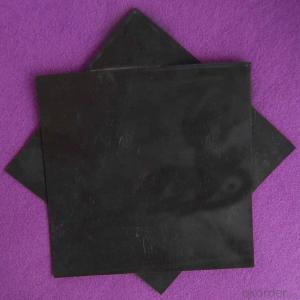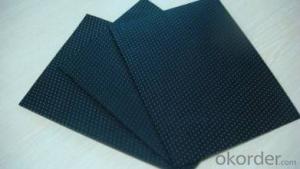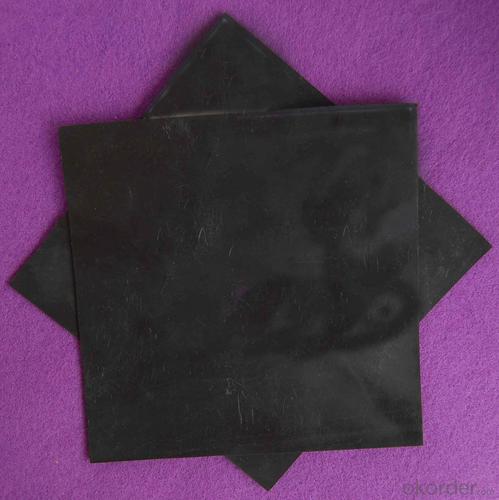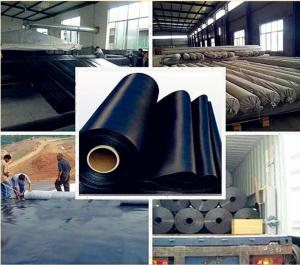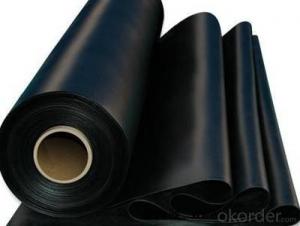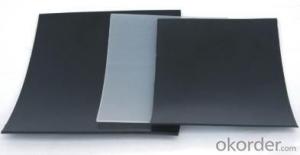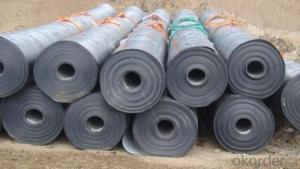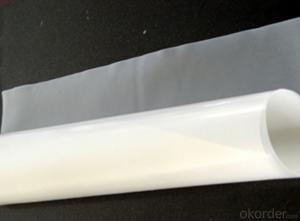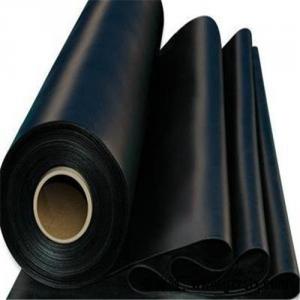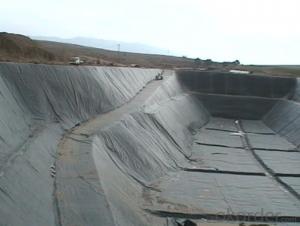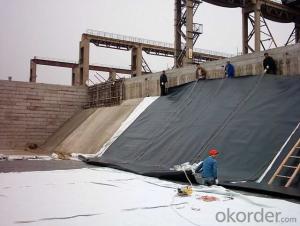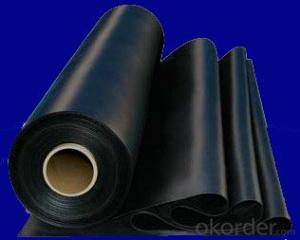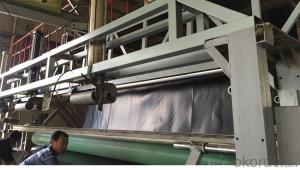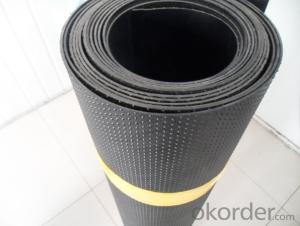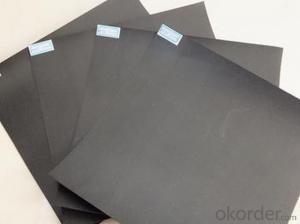ASTM Standard HDPE Geomembrane Sheet / Composite HDPE ASTM Standard Geomembrane Sheet for Landfill
- Loading Port:
- Tianjin
- Payment Terms:
- TT OR LC
- Min Order Qty:
- 1000 m²
- Supply Capability:
- 900000 m²/month
OKorder Service Pledge
OKorder Financial Service
You Might Also Like
Geomembrane waterproofing material
1) Good physical and mechanic performance
2) High tearing resistance, strong deformation adaptability
3) Puncture-resisting, aging resisting, ultra-violet radiation, oil and salt, and corrosion resistance
4) Good adaptability to high and low temperature, non-toxicity, long service life
5) Good waterproof, drainage, anti-seepage and damp proof effects
6) Complete width and thickness specifications, low cost and easy installation
Product introduction
Geomembrane can be divided according to the different materials HDPE geomembrane , matte geomembrane , LDPE geomembrane , LLDPE geomembrane , EVA geomembrane , ECB geomembrane , PVC geomembrane.
Product Use
1, City landfill ;
2, Roads, railways , drainage , irrigation , tunnels, dikes, dams , gates seepage, seepage accumulator library ;
3, Fluid channels , solid manure dumps impermeable ;
4, impermeable roof , building basements, underground storage , underground garage moisture ;
5, pile cofferdam film , land reclamation from the sea , marina projects etc.
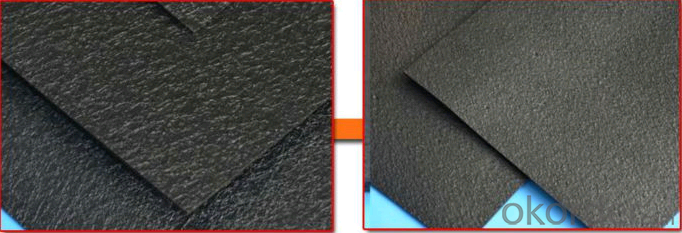

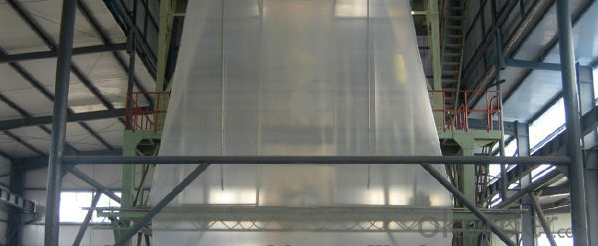


FAQ
How about the delivery time?Lead time since receipt of 30% T/T deposit payment: 3 weeks.(Samples will be prepared within 3 days.)
2.What's are the MOQ?Generally speaking, the MOQ is one container, but we can provide you samples for quality inspection.
3. Do you charge for the samples?Accordeing to our company policy, the samples are free, we only charge the freight fee. And we will return the freight fee during the next order.
4. Can you produce according to customers' design?Sure, we are professional manufacturer, OEM and ODM are both welcome.
- Q: Can geomembranes be used in decorative waterfalls and cascades?
- Yes, geomembranes can be used in decorative waterfalls and cascades. They are commonly used in such applications to line and contain the water, preventing leakage and ensuring proper flow. Additionally, geomembranes offer durability, flexibility, and resistance to UV rays, making them suitable for creating aesthetically pleasing and functional water features.
- Q: How do geomembranes prevent gas leakage in storage facilities?
- Geomembranes prevent gas leakage in storage facilities by acting as a barrier between the stored gases and the surrounding environment. These synthetic liners are impermeable to gases, preventing their migration through the walls or floor of the storage facility. This containment system ensures that the gases remain safely stored, minimizing the risk of leaks or environmental contamination.
- Q: What are the considerations for geomembrane selection in oil and gas pipeline corrosion protection?
- There are several considerations for geomembrane selection in oil and gas pipeline corrosion protection. Firstly, the geomembrane should have excellent chemical resistance to withstand the harsh environment of oil and gas pipelines. It should be able to resist corrosion from various substances such as hydrocarbons, acids, and alkalis. Secondly, the geomembrane should have high tensile strength and puncture resistance to prevent any damage or leakage in the pipeline system. Additionally, the geomembrane should have good flexibility and elongation properties to accommodate any movement or settlement that may occur in the pipeline. Finally, the geomembrane should be compatible with other components of the corrosion protection system, such as coatings or cathodic protection methods, to provide a comprehensive corrosion resistance solution.
- Q: How are geomembranes tested for durability?
- Geomembranes are tested for durability through a series of rigorous tests that assess their resistance to various environmental factors. These tests include measuring their tensile strength, puncture resistance, UV stability, chemical resistance, and dimensional stability. Additionally, accelerated aging tests are conducted to simulate long-term exposure to harsh conditions. By subjecting geomembranes to these tests, their durability and ability to withstand different conditions can be accurately evaluated.
- Q: What are the technical parameters of seepage-proof geomembranes?
- serial number item indicator common environmental protection 1 thickness mm 0.2 to 4 2 width m 2.5 to 8 3 tensile strength (vertically and horizontally) MPa≥17 ≥25 4 breaking elongation rate (vertically and horizontally) % ≥450 ≥550 5 angle tear strength N/mm ≥80 ≥110 6 carbon black content % 2.0 to 3.0 2.0 to 3.0 7 resistance to environment stress cracking F20 ≥1500 8 low-temperature impact in -70℃ approved 9 oxidative inductive time in 200℃ ≥20
- Q: What kind of membrane switch material is good?
- Most mask material of the membrane switch is of polyester material, mainly including polyvinyl chloride (PVC), polycarbonate (PC), and polyester (PET). These three kinds of material all have their own advantages and disadvantages, and you can choose from them according to your own needs.
- Q: How to use the mobile phone laminator?
- Mobile phone laminator has many advantages, such as wide compatibility, good effect of sticking film, simple operation, multipoint operation, safety and saving materials; mobile phone laminator is fully compatible with the brand transparent protective film and a variety of digital products, such as mobile phones, MP3, MP4, camera, remote controller and notebook computers. It is fully mechanized in the whole process, sticking the mobile phone film is remarkably smooth with no bubbles and no wrinkles. Besides, it has good safety and free of grilling. Fool-type operation just need to press the button, it will have the best quality, you do not spend much time to practice the sticking film technology, everyone can become a master of sticking the film, it can be finished the whole process in three minutes, which reduce the waiting time of customer, and improve the efficiency of 5 to 10 times. A machine is equal to three skilled master, you make money faster and easier. Mobile phone laminator is equipped with a variety of templates with flexible configuration, which can save the raw materials. It reduce the consumable items by 50% to 80% than the fixed consumable items area of tranditional sticking method.
- Q: How do geomembranes handle soil movement?
- Geomembranes handle soil movement by providing a flexible and impermeable barrier that can accommodate the natural settlement, expansion, and contraction of the soil. The geomembrane's high tensile strength and elongation properties allow it to withstand the stresses exerted by soil movement without compromising its integrity. Additionally, proper anchoring and installation techniques, as well as the use of geotextiles and other reinforcement materials, can further enhance the geomembrane's ability to handle soil movement.
- Q: Which one is better, electric heating film and oil heater
- Electric heating film is a good choice, a lot of Korean restaurants here are using it
- Q: Are geomembranes resistant to root penetration?
- Yes, geomembranes are typically designed to be resistant to root penetration. They are commonly used in various applications to prevent the intrusion of plant roots, providing an effective barrier against their growth and potential damage.
Send your message to us
ASTM Standard HDPE Geomembrane Sheet / Composite HDPE ASTM Standard Geomembrane Sheet for Landfill
- Loading Port:
- Tianjin
- Payment Terms:
- TT OR LC
- Min Order Qty:
- 1000 m²
- Supply Capability:
- 900000 m²/month
OKorder Service Pledge
OKorder Financial Service
Similar products
Hot products
Hot Searches
Related keywords
